Input interpretation

NH_3 ammonia + PbO_2 lead dioxide ⟶ H_2O water + N_2 nitrogen + Pb lead
Balanced equation
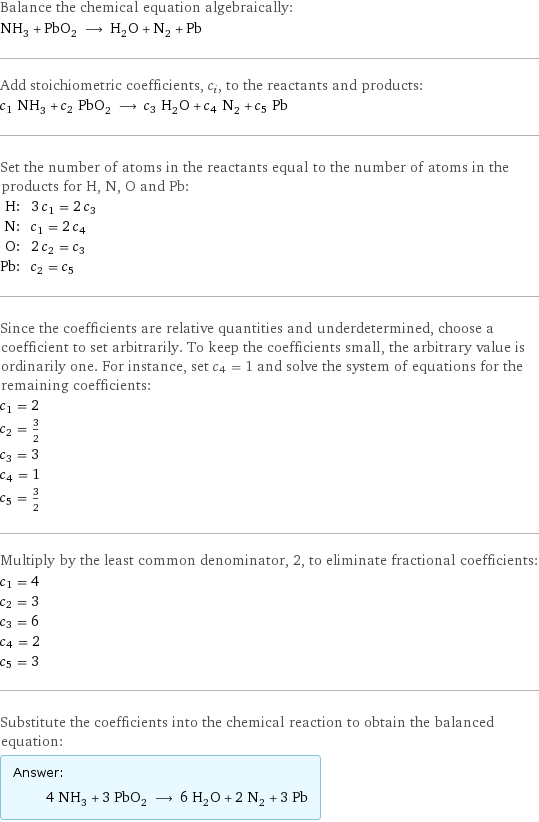
Balance the chemical equation algebraically: NH_3 + PbO_2 ⟶ H_2O + N_2 + Pb Add stoichiometric coefficients, c_i, to the reactants and products: c_1 NH_3 + c_2 PbO_2 ⟶ c_3 H_2O + c_4 N_2 + c_5 Pb Set the number of atoms in the reactants equal to the number of atoms in the products for H, N, O and Pb: H: | 3 c_1 = 2 c_3 N: | c_1 = 2 c_4 O: | 2 c_2 = c_3 Pb: | c_2 = c_5 Since the coefficients are relative quantities and underdetermined, choose a coefficient to set arbitrarily. To keep the coefficients small, the arbitrary value is ordinarily one. For instance, set c_4 = 1 and solve the system of equations for the remaining coefficients: c_1 = 2 c_2 = 3/2 c_3 = 3 c_4 = 1 c_5 = 3/2 Multiply by the least common denominator, 2, to eliminate fractional coefficients: c_1 = 4 c_2 = 3 c_3 = 6 c_4 = 2 c_5 = 3 Substitute the coefficients into the chemical reaction to obtain the balanced equation: Answer: | | 4 NH_3 + 3 PbO_2 ⟶ 6 H_2O + 2 N_2 + 3 Pb
Structures

+ ⟶ + +
Names

ammonia + lead dioxide ⟶ water + nitrogen + lead
Reaction thermodynamics
Enthalpy
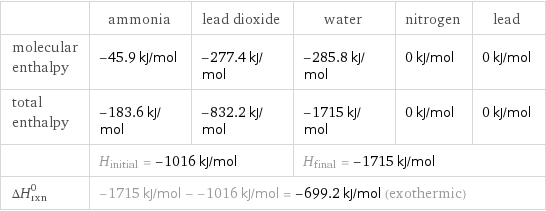
| ammonia | lead dioxide | water | nitrogen | lead molecular enthalpy | -45.9 kJ/mol | -277.4 kJ/mol | -285.8 kJ/mol | 0 kJ/mol | 0 kJ/mol total enthalpy | -183.6 kJ/mol | -832.2 kJ/mol | -1715 kJ/mol | 0 kJ/mol | 0 kJ/mol | H_initial = -1016 kJ/mol | | H_final = -1715 kJ/mol | | ΔH_rxn^0 | -1715 kJ/mol - -1016 kJ/mol = -699.2 kJ/mol (exothermic) | | | |
Entropy
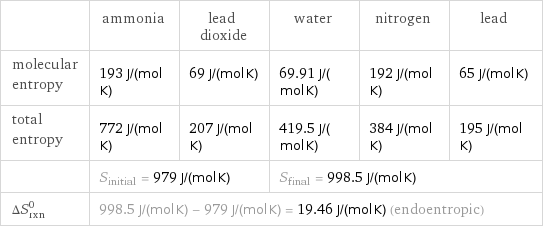
| ammonia | lead dioxide | water | nitrogen | lead molecular entropy | 193 J/(mol K) | 69 J/(mol K) | 69.91 J/(mol K) | 192 J/(mol K) | 65 J/(mol K) total entropy | 772 J/(mol K) | 207 J/(mol K) | 419.5 J/(mol K) | 384 J/(mol K) | 195 J/(mol K) | S_initial = 979 J/(mol K) | | S_final = 998.5 J/(mol K) | | ΔS_rxn^0 | 998.5 J/(mol K) - 979 J/(mol K) = 19.46 J/(mol K) (endoentropic) | | | |
Equilibrium constant
![Construct the equilibrium constant, K, expression for: NH_3 + PbO_2 ⟶ H_2O + N_2 + Pb Plan: • Balance the chemical equation. • Determine the stoichiometric numbers. • Assemble the activity expression for each chemical species. • Use the activity expressions to build the equilibrium constant expression. Write the balanced chemical equation: 4 NH_3 + 3 PbO_2 ⟶ 6 H_2O + 2 N_2 + 3 Pb Assign stoichiometric numbers, ν_i, using the stoichiometric coefficients, c_i, from the balanced chemical equation in the following manner: ν_i = -c_i for reactants and ν_i = c_i for products: chemical species | c_i | ν_i NH_3 | 4 | -4 PbO_2 | 3 | -3 H_2O | 6 | 6 N_2 | 2 | 2 Pb | 3 | 3 Assemble the activity expressions accounting for the state of matter and ν_i: chemical species | c_i | ν_i | activity expression NH_3 | 4 | -4 | ([NH3])^(-4) PbO_2 | 3 | -3 | ([PbO2])^(-3) H_2O | 6 | 6 | ([H2O])^6 N_2 | 2 | 2 | ([N2])^2 Pb | 3 | 3 | ([Pb])^3 The equilibrium constant symbol in the concentration basis is: K_c Mulitply the activity expressions to arrive at the K_c expression: Answer: | | K_c = ([NH3])^(-4) ([PbO2])^(-3) ([H2O])^6 ([N2])^2 ([Pb])^3 = (([H2O])^6 ([N2])^2 ([Pb])^3)/(([NH3])^4 ([PbO2])^3)](../image_source/454942c2b32131c48ccd319d5e6508a6.png)
Construct the equilibrium constant, K, expression for: NH_3 + PbO_2 ⟶ H_2O + N_2 + Pb Plan: • Balance the chemical equation. • Determine the stoichiometric numbers. • Assemble the activity expression for each chemical species. • Use the activity expressions to build the equilibrium constant expression. Write the balanced chemical equation: 4 NH_3 + 3 PbO_2 ⟶ 6 H_2O + 2 N_2 + 3 Pb Assign stoichiometric numbers, ν_i, using the stoichiometric coefficients, c_i, from the balanced chemical equation in the following manner: ν_i = -c_i for reactants and ν_i = c_i for products: chemical species | c_i | ν_i NH_3 | 4 | -4 PbO_2 | 3 | -3 H_2O | 6 | 6 N_2 | 2 | 2 Pb | 3 | 3 Assemble the activity expressions accounting for the state of matter and ν_i: chemical species | c_i | ν_i | activity expression NH_3 | 4 | -4 | ([NH3])^(-4) PbO_2 | 3 | -3 | ([PbO2])^(-3) H_2O | 6 | 6 | ([H2O])^6 N_2 | 2 | 2 | ([N2])^2 Pb | 3 | 3 | ([Pb])^3 The equilibrium constant symbol in the concentration basis is: K_c Mulitply the activity expressions to arrive at the K_c expression: Answer: | | K_c = ([NH3])^(-4) ([PbO2])^(-3) ([H2O])^6 ([N2])^2 ([Pb])^3 = (([H2O])^6 ([N2])^2 ([Pb])^3)/(([NH3])^4 ([PbO2])^3)
Rate of reaction
![Construct the rate of reaction expression for: NH_3 + PbO_2 ⟶ H_2O + N_2 + Pb Plan: • Balance the chemical equation. • Determine the stoichiometric numbers. • Assemble the rate term for each chemical species. • Write the rate of reaction expression. Write the balanced chemical equation: 4 NH_3 + 3 PbO_2 ⟶ 6 H_2O + 2 N_2 + 3 Pb Assign stoichiometric numbers, ν_i, using the stoichiometric coefficients, c_i, from the balanced chemical equation in the following manner: ν_i = -c_i for reactants and ν_i = c_i for products: chemical species | c_i | ν_i NH_3 | 4 | -4 PbO_2 | 3 | -3 H_2O | 6 | 6 N_2 | 2 | 2 Pb | 3 | 3 The rate term for each chemical species, B_i, is 1/ν_i(Δ[B_i])/(Δt) where [B_i] is the amount concentration and t is time: chemical species | c_i | ν_i | rate term NH_3 | 4 | -4 | -1/4 (Δ[NH3])/(Δt) PbO_2 | 3 | -3 | -1/3 (Δ[PbO2])/(Δt) H_2O | 6 | 6 | 1/6 (Δ[H2O])/(Δt) N_2 | 2 | 2 | 1/2 (Δ[N2])/(Δt) Pb | 3 | 3 | 1/3 (Δ[Pb])/(Δt) (for infinitesimal rate of change, replace Δ with d) Set the rate terms equal to each other to arrive at the rate expression: Answer: | | rate = -1/4 (Δ[NH3])/(Δt) = -1/3 (Δ[PbO2])/(Δt) = 1/6 (Δ[H2O])/(Δt) = 1/2 (Δ[N2])/(Δt) = 1/3 (Δ[Pb])/(Δt) (assuming constant volume and no accumulation of intermediates or side products)](../image_source/f41d1bf9780831702a3528c099324176.png)
Construct the rate of reaction expression for: NH_3 + PbO_2 ⟶ H_2O + N_2 + Pb Plan: • Balance the chemical equation. • Determine the stoichiometric numbers. • Assemble the rate term for each chemical species. • Write the rate of reaction expression. Write the balanced chemical equation: 4 NH_3 + 3 PbO_2 ⟶ 6 H_2O + 2 N_2 + 3 Pb Assign stoichiometric numbers, ν_i, using the stoichiometric coefficients, c_i, from the balanced chemical equation in the following manner: ν_i = -c_i for reactants and ν_i = c_i for products: chemical species | c_i | ν_i NH_3 | 4 | -4 PbO_2 | 3 | -3 H_2O | 6 | 6 N_2 | 2 | 2 Pb | 3 | 3 The rate term for each chemical species, B_i, is 1/ν_i(Δ[B_i])/(Δt) where [B_i] is the amount concentration and t is time: chemical species | c_i | ν_i | rate term NH_3 | 4 | -4 | -1/4 (Δ[NH3])/(Δt) PbO_2 | 3 | -3 | -1/3 (Δ[PbO2])/(Δt) H_2O | 6 | 6 | 1/6 (Δ[H2O])/(Δt) N_2 | 2 | 2 | 1/2 (Δ[N2])/(Δt) Pb | 3 | 3 | 1/3 (Δ[Pb])/(Δt) (for infinitesimal rate of change, replace Δ with d) Set the rate terms equal to each other to arrive at the rate expression: Answer: | | rate = -1/4 (Δ[NH3])/(Δt) = -1/3 (Δ[PbO2])/(Δt) = 1/6 (Δ[H2O])/(Δt) = 1/2 (Δ[N2])/(Δt) = 1/3 (Δ[Pb])/(Δt) (assuming constant volume and no accumulation of intermediates or side products)
Chemical names and formulas
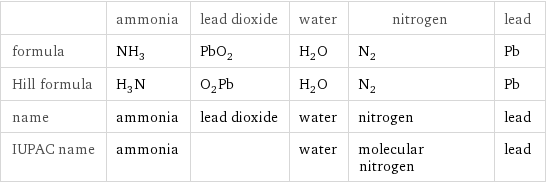
| ammonia | lead dioxide | water | nitrogen | lead formula | NH_3 | PbO_2 | H_2O | N_2 | Pb Hill formula | H_3N | O_2Pb | H_2O | N_2 | Pb name | ammonia | lead dioxide | water | nitrogen | lead IUPAC name | ammonia | | water | molecular nitrogen | lead
Substance properties
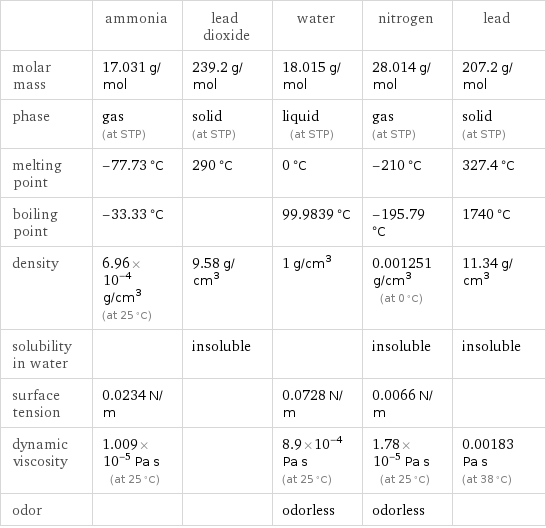
| ammonia | lead dioxide | water | nitrogen | lead molar mass | 17.031 g/mol | 239.2 g/mol | 18.015 g/mol | 28.014 g/mol | 207.2 g/mol phase | gas (at STP) | solid (at STP) | liquid (at STP) | gas (at STP) | solid (at STP) melting point | -77.73 °C | 290 °C | 0 °C | -210 °C | 327.4 °C boiling point | -33.33 °C | | 99.9839 °C | -195.79 °C | 1740 °C density | 6.96×10^-4 g/cm^3 (at 25 °C) | 9.58 g/cm^3 | 1 g/cm^3 | 0.001251 g/cm^3 (at 0 °C) | 11.34 g/cm^3 solubility in water | | insoluble | | insoluble | insoluble surface tension | 0.0234 N/m | | 0.0728 N/m | 0.0066 N/m | dynamic viscosity | 1.009×10^-5 Pa s (at 25 °C) | | 8.9×10^-4 Pa s (at 25 °C) | 1.78×10^-5 Pa s (at 25 °C) | 0.00183 Pa s (at 38 °C) odor | | | odorless | odorless |
Units
